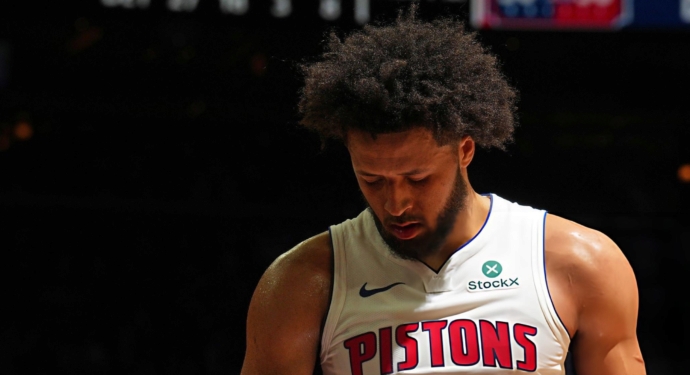From rock bottom to the top: How Cade Cunningham led Detroit’s revival
Maybe it was always meant to happen this way – through the grind, the noise, and the heartbreak. Over the past few years, Detroit basketball was defined by its pain. A record-breaking 28-game losing streak. Missed lottery picks. False starts. The Motor City, once the heart of NBA toughness, had become an afterthought.
But lately, that’s changing – fast.
Led by Cade Cunningham, the Detroit Pistons have stormed out to a stunning 9-2 start, sitting atop the Eastern Conference standings. They’ve done it not through star-chasing or blockbuster trades, but through patience, internal player development, and a belief that the foundation they’ve built would eventually bear fruit.
And at the center of it all is the quiet leader who never ran from the challenge.
Cade’s time has come
Cade Cunningham’s leap into superstardom has felt less like a breakout and more like a long-overdue arrival. The 24-year-old guard has been on an absolute tear to open the season, stringing together the kind of performances that remind you why he was once the No. 1 pick in his draft.
He’s orchestrated the offense with poise and precision – highlighted by an 18-assist night earlier this season – and imposed his will on both ends. Then came the moment that made the league stop and take notice: a 46-point, 12-rebound, 11-assist, 5-steal, 2-block masterpiece in an overtime comeback win against the Wizards.
It wasn’t just another great game. It was a declaration.
Cunningham has arrived not only as a star but as a symbol of Detroit’s revival – a player who stayed when things were at their worst, who never complained, never pointed fingers, and never asked out. Drafted by one of the worst teams in NBA history, he endured the losing, the questions, and the scrutiny – and he came out sharper, stronger, and hungrier.
The Cunningham-Duren connection
Every great franchise turnaround starts with a pairing that just works. For the Pistons, that’s Cade Cunningham and Jalen Duren – the new-age guard-big duo that’s fast becoming one of the most dangerous in basketball.
Duren, still only 21, has blossomed into a nightly double-double machine. He’s stronger, more agile, and far more decisive in pick-and-roll reads – a perfect complement to Cunningham’s pace and vision. His recent 20-point, 20-rebound outing was a glimpse of what’s to come.
Their chemistry has been undeniable. Cunningham manipulates defenses with patience; Duren punishes them with power, and both connect on lobs and passes off the pick and roll that made them the most lethal combo so far (scoring the most pass-to-score duos in the league). They’ve developed a rhythm that evokes the great guard-big tandems of the past – the kind that can anchor a team for years to come.
When Cunningham and Duren share the floor, the Pistons’ offense now hums with a balance that few young teams can match.
The young core’s internal progression
But this isn’t just a two-man show. Detroit’s rise has been fueled by the steady internal improvement of its entire young core.
Ausar Thompson has taken a noticeable leap, attacking off the dribble more aggressively and showing improved confidence as a slasher. His defense, as always, remains elite — the kind of game-changing activity that sparks fast breaks and deflates opposing stars.
Isaiah Stewart, once a raw energy guy, now stretches the floor with a much-improved jumper. His ability to switch across positions gives Detroit defensive versatility few teams can replicate, and his shotblocking has been one of the best in the league.
Meanwhile, Ron Holland, the youngster known for his relentless motor, has brought a surge of intensity off the bench – the type of energy that can tilt the flow of games.
And though Jaden Ivey has yet to make his season debut due to injury, his eventual return adds another dynamic playmaker who can ease Cunningham’s load and bring even more firepower to the offense.
Detroit’s front office also deserves credit for complementing its young core with smart veteran additions. Duncan Robinson brings much-needed spacing and shooting, while Caris LeVert provides shot creation and playmaking for the second unit. These aren’t headline-grabbing moves – but they’re the kind that win games in November and matter even more come April.
Built, not bought
The Pistons’ resurgence stands in stark contrast to today’s NBA trend of instant gratification. They didn’t rush the rebuild. They didn’t mortgage their future for short-term gains. Instead, they trusted their process – and more importantly, their people.
Head coach JB Bickerstaff has emphasized accountability, effort, and trust, and the results are showing. Detroit defends with purpose, shares the ball, and plays with the kind of unity that only comes from shared struggle.
This team remembers what it felt like to be at the bottom – and they play like they never want to go back.
If there’s a city that appreciates resilience, it’s Detroit. The Pistons’ early success isn’t just about basketball, but it’s about identity. It’s about a fan base that’s waited years for something to believe in again.
Cade Cunningham embodies that spirit. He doesn’t talk about saving the franchise. He just shows up, competes, and leads. He’s the face of a movement – not by flash, but by example.
For the first time in a long time, Detroit basketball means something again.
The Pistons might not stay atop the East all season – they’re still young, still learning, still growing. But what’s undeniable is that the foundation is real, the culture is changing, and the superstar they’ve been waiting for is already here.
Detroit’s rebuild wasn’t supposed to take off this fast. But Cade Cunningham had other plans.
